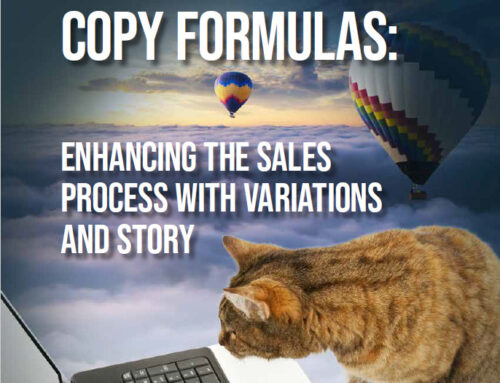As a copywriter, I’m always wondering if my copy could be more effectively written. Could there be a copy “formula” I haven’t tried that would generate better results?
I’ve used the Sales Process for decades with great success, across websites, email, and direct mail efforts. I recently reviewed many of its variations — PAS and other acronym-named copy formulas — that I’d forgotten about. Each has one or two interesting elements that can be helpful to consider including. Even more interesting, I noticed that some of those elements have reappeared in the new Story approach.
I’m excited about the results from the new Story approach because:
- The Story approach really does a good job of making you focus on creating a more differentiated brand promise(something few websites really do well)
- It weaves in credibility-boosting elements and the answering of common objections right into the main sales message (elements many websites are missing or have misplaced into obscure locales, rather than integrating them into the main “why we’re different” story for each product or service )
As I’ve been working with the Story approach across my client websites, I’ve noticed how I can use the answers to each of the 7 Story approach steps to formulate specific elements of a stronger message. For example:
Step 1, “What does your target want?” should be answered in your Home page main headline in combination with Step 3, “Why are we the most credible guide to deliver what the target wants?” By combining answers to Step 1 and Step 3 of the Story approach, you begin to craft not only your Home page headline, but a much stronger “why buy ours” brand message.
We used to talk about “brand advertising” as something completely different from “direct marketing” efforts that drive a lead or sale. Realistically, a lead-generating or sales-generating effort won’t be as effective without incorporating a strong brand promise.
So perhaps digital marketing has finally ushered in a copywriting era where building a brand can — and should — be achieved while you’re driving the lead or sale. Because each is stronger with the other. And perhaps the Story approach is the copy formula we all need to be testing to bring brand and demand finally together as one.
Want to build the Story approach into your website and email messages? See our on-demand workshops
Here’s the full transcript of the webinar . . .
How does copy become more compelling?
One way is to be more specific to your audience with your messages. Every audience doesn’t have the same concerns. And every product or service doesn’t face the same sales challenges.
Your copy approach or message strategy for each product or service should be tailored to the familiarity of your audience with the product/service category, their most common questions and objections, and the competitive situation.
The Sales Process – when you’re selling by phone, in person, in print, or in digital media
What steps does your current sales message take your target audience through?
Always discuss this with your copywriter or creative team. Leaving out a critical step (typically, answering objections or proving your credibility) or adding in elements that address your particular challenges can make the difference between a positive or negative ROI from the effort.
There are still some copywriters that say they use AIDA to craft their sales message. AIDA stands for Awareness, Interest, Desire, and Action. They are the stages that customers follow when they make a purchase decision.
But it’s not a specific direction for your copy – and it’s not a strong-enough strategy to close the sale. The stages of AIDA are not persuasion components. – they’re just a general guide.
Those general steps wouldn’t help a salesperson.
Just think if you were a sales manager, you’re hiring a new sales rep, and you’re in charge of training, You would never say to your new sales rep.:
“Here’s all you need to do — just generate some Awareness, then some Interest, build Desire and then motivate the Action.”
It’s not enough to help a salesperson. As marketers, we’re selling in words. So, if AIDA isn’t specific enough to help a salesperson, it may not reveal enough insight to guide copywriters.
Great salespeople follow a process called the Sales Process. If we’re selling with words, we should be following a similar process.
The most effective message components tend to be what your best salespeople would say. The Sales Process steps give you a much more specific direction for your copy:
STEP ONE: Remind of some pain and/or promise some pleasure.
The Sales Process typically starts out with some pain and/or some pleasure:
“Are you having a problem with . . . are you struggling with?”
and/or
“Wouldn’t it be great if you could, . . .”
STEP TWO: We have the solution.
Present your solution.
STEP THREE: “Sizzle” the solution.
Tell me “what’s in it for me” – all of the benefits, not the facts. Tell me why I should care, what is your product/service going to do for me.
STEP FOUR: Why take action now.
Give me a specific offer and tell me how to get it.
If you’re generating leads, you stop there. You’ve got me interested with the pain/pleasure lead in. You’ve told me you’ve got a webinar or a piece of downloadable content. You tell me all the things I’m going to learn, and then tell me how to get it.
If you’re selling by ecommerce, you have to take some additional steps . . .
(If ecommerce) STEP FIVE: Answer objections and build credibility.
As soon as we leave an objection in the prospect’s mind, they’re not going to take action – and we’ve just wasted the budget we spent driving that traffic.
If I was selling in person or over the phone, I’d have an opportunity to find out what the objections were. I’d say something like, “what’s standing in the way of you making a decision today?” Hopefully, the prospect would tell me what the issues were, and then I’d have an opportunity to answer those objections. In print or digital, we have to address those objections BEFORE the prospect leaves the page.
If you have proof – especially numbers – use them to prove what kind of results your audience will get from your solution. Third-party reviews or customer testimonials (especially from a well-known customer) can help to answer objections.
Be sure to have a clear answer to: “why should I buy from you?” It should be a clear benefit statement that no other competitor can say.
STEP SIX: Re-pitch the offer.
Once the objections are answered, go for the close. With ecommerce, the offer is the something extra that motivates the sale TODAY – a special bundled price, a gift with purchase, free shipping, etc.
As you craft the steps in your Sales Process, focus on the target customer you’re writing for:
Address their problems, the benefits most relevant to them, and their most likely objections.
Write like that target Persona is sitting across from you and you’re having a discussion.
If your content doesn’t sound the way you’d say it if that target Persona was sitting in front of you, time to revise until it does.
Enhance Your Sales Message with 6 Persuasive Additions
What could your sales message be missing? What “tweaks” could you make or suggest to your messaging to make it more persuasive?
Within the general Sales Process copy formula, there are many variations – each adding an interesting component to your messaging that can make a significant difference in results.
Here’s how and when you might incorporate these variation components to boost the power of your sales message.
Could you make the prospect really experience the pain?
Maybe your prospects are putting off addressing a particular pain – or they don’t understand the implications of waiting.
In these cases, you can create really powerful messaging by “prolonging” the pain discussion. You want to agitate the pain the prospect may be feeling.
In this messaging strategy, you make the prospect remember how the pain feels, make the prospect experience it, point out the implications of the pain – so prospects become highly motivated to solve it.
“Is your bank falling behind digitally? Are your Relationship Managers losing deals because they can’t respond quickly? And is your margin suffering while you struggle to stay competitive?”
One consultant has found great success with agitating the pain in the email conversion series. His 3-email plan focuses on making the prospect feel and experience the different elements of the pain.
Maybe your prospects don’t recognize the problem . . .
Do you need to describe the problem to your prospects? In some cases, your audience may not recognize the problem that would give your solution a key advantage.
I have a client that sells real estate errors and omissions insurance to real estate licensees. A lot of licensees don’t realize that if they choose a generic policy used by many industries, it may not cover their specific risks, like lockbox protection and Fair Housing concerns – risks that are specific to their real estate activities.
So, I have to weave into the Sales Process a description of the problem, because the audience doesn’t recognize the key problem or difference with competitive solutions.
Empathize with your prospects to prove you understand the situation
Many prospects look for solutions providers who have experience in and understand their particular industry.
Would your message benefit from the addition of some empathy — some “we know how you feel, we understand your pain”?
Using empathy can be a good way to illustrate your knowledge of the prospect’s industry and the particular challenges he/she may be facing.
Build credibility in every message and on every web page
(The Sales Process actually encourages this – but it’s the most common omission in messaging.)
Are you using your strongest credibility elements to make it crystal clear to your audience that you’re the best company to deliver what they need?
If you have proof — if you have any numbers that illustrate what kind of results your audience is going to get from your solution — make them a prominent part of your message (in at least a subhead).
I recently reviewed copy from a major software provider – and buried within a paragraph, about 3 paragraphs down on the page, was a major statement of proof! “Users save up to XX minutes on . . . .” It’s now the main subhead on the page – where it should be so visitors don’t miss it!
If you have customer reviews or third-party reviews, weave them into your email messages and web pages. Don’t assume web visitors will search for them – because in some cases, the reviews are what will keep your visitors on the site. If reviews aren’t prominent, visitors may not be interested enough to stick around and find them.
Credibility builders are critical in getting a sale – because they typically help to answer objections.
Discredit other solutions to create your own competitive advantage
What do you do if competitive solutions might actually seem superior to yours – or at least more up-to-date?
I have a client that sells online courses, and all of their competition sells video courses, audio courses, or in person courses. But my client sells online courses with downloadable PDFs.
So, I did some research on effective learning. And I discovered that you can actually read a PDF faster than going through a video or an audio file. (And, of course, you have more control with a PDF and can more easily go back or spend more time with a specific topic.) Plus, seeing the words may help you retain the information. And you can easily print pages to make note-taking easy.
So, the research gave me a messaging plan to help prove my client solution was the best one – and subtly (without naming the other types of courses) discredit other solutions at the same time.
Consequences of failing to take action today
Does your messaging always point out what prospects will lose if they don’t take action today?
“Every day you delay is a day you could have . . .” or “It’s costing the average company $XXX every day without this upgrade.”
Point out the dangers of not taking action today, to remind prospects of the real cost of waiting.
The Story Approach as a Messaging Strategy
The “Story Approach” has nothing to do with testimonials if that’s what you’re thinking.
It’s an approach for crafting more persuasive sales copy that’s driven by your answers to 7 key questions. Formulating the answers to those questions helps you create your brand “story.”
The Story Approach helps you focus on your target audience — and discover the key points of differentiation that are going to get that audience excited.
The end result is a stronger, more unique, memorable brand promise.
The Story Approach Framework
The particular “Story Approach” we’re going to walk through is from Donald Miller’s book, “Building a Story Brand.”
This Story Approach helps you think of new directions for your overall message, because it challenges you to really analyze the prospect situation and think about what the prospect is going through.
You’ll want to end up with a simple, relevant, repeatable, memorable single statement to summarize the story. That’s your whole brand promise.
The prospect will be the hero in your story (versus your company). Of course, that’s the challenge, because we all tend to want to talk about our company or our products – with a lot of “we” and “our.”
But we want our message to be all about our prospects — because our prospects could care less about our company and our products. They only care about what’s in it for them.
To implement the Story Approach, you’ll answer 7 key questions.
You want to craft a clear statement in answer to each question, that positions you as a trusted guide to solve the prospect’s problem.
Finally, your product or solution should transform your prospects, help them become a better version of themselves or inspire them or change their life. This works both for consumers as well as business prospects.
Answer 7 Key Questions to Guide Your Messaging
The seven steps in the Story Approach are similar to the Sales Process, but they mix things around a bit:
- What does the prospect want?
Spend some time really getting down to the basic needs of your prospect. Get beyond the product or service you sell — and think about the end result your prospect needs.
For example, we sell website creation, copywriting, and website management services.
But that’s not the crux of what our prospects want. They want to generate more leads or more sales cost-effectively. That’s the basic want we should address.
Try to identify a specific desire that you can become known for helping your customers achieve as you go through each of these seven questions.
- What are the things standing in the way?
Are there problems or challenges standing in the way of that prospect getting what he or she wants? Walk through the decision process step-by-step the way your prospect would, starting with an online search (if that makes sense for your product or service) – and see how easy it is to identify the right websites that might deliver what the prospect wants.
(Questions 1 and 2 combined are similar to the “Agitation” copy variation.)
- Why are we the best “guide” to solve this problem?
This is where you showcase your expertise and build credibility with your particular prospects.
You might use empathy here: “We understand your situation and we have the expertise to deliver it.”
- What’s our clear plan of action for the prospect?
Give your prospect clear steps to take. “Here’s all you need to do.”
- How can we challenge prospects to take action?
What is going to motivate your prospects to take action NOW? Try to reduce the risk with a guaranty as part of your Offer.
- What will happen if prospects don’t take action?
Remind prospects of what they will miss every day they don’t take action.
- What is the successful vision of life after the purchase?
Finish your brand story with a view of how great their life will be once they take advantage of your product or service.
Where the Sales Process presents the benefits, pitches the offer, and addresses objections – typically in that order — the Story Approach weaves the benefits and answers objections throughout the message.
Using the Story Approach as a Copy Formula
The Story Approach is really a variation of the Sales Process.
To create your “story,” you’ll draft and hone answers to 7 key questions.
- Go through the 7 questions and just start writing whatever comes to mind. You want to get ideas down in a draft. Don’t worry about writing copy or finished messaging initially. (This is a great exercise for a marketing team, to come up with a stronger brand promise!)
- Then work to hone the words. As you polish your answers, you’ll want to come up with a single statement in answer to each question.
The Story Approach helps you focus on your target audience — and discover the key points of differentiation that are going to get that audience excited.
The end result is a stronger, more unique, memorable brand promise – that can drive leads and sales more effectively.
So, let’s have a look at those seven steps, using a case study for a client that sells online courses.
Step one. What does the prospect want?
Hopefully there’s a specific desire that you can become known for helping your customers achieve.
Our client has multiple audiences that are rather diverse. They sell continuing education courses in 47 states to insurance agents and certified financial planners. They also sell continuing education for real estate agents, but only in California. Their other audience is for Californians who want to become a real estate agent or a broker.
These audiences are rather diverse in what they want. The continuing education people just want to get it done. They want to get their continued education done fast, as easily and painlessly, and as inexpensively as they possibly can.
Our California real estate people need to actually learn, because they need to pass the real estate exam. So how do you turn these two ideas into one statement?
We started out with:
Most Effective Way to Learn and Pass
Everybody needs to pass. That’s critical to finishing each course.
But we looked at the competition – offering video courses, audio courses, in-person courses. Our client offers courses as downloadable PDFs. We discovered that PDFs may actually be a more effective way to learn over these other options, because it’s easier to work at your own pace. So that’s why we led with “most effective way to learn.”
This client’s entire brand promise now relates to the most effective way to learn.
Step two: what’s standing in the way, what’s the problem? What are the frustrations that your audience goes through?
In looking at these online courses, there are a ton of different companies offering them. So how does a prospect decide among so many choices?
What if you make the wrong decision? What if you choose a class that takes you longer to finish? What if you choose a course format that makes it hard to go back if you miss something? And what if you do all the coursework and don’t pass?
How do you take all that frustration and turn it into a single emotionally charged statement?
What if you choose a class that actually takes you longer to finish or that you struggle to pass, or a format that’s frustrating when you’re trying to learn?
Step three: We are your guide – and uniquely able to give you what you want
You want to empathize with the prospect’s feelings, but establish your expertise. “Hey, we can help you. We’ve been there. We understand your pain, but we can get you through it. Experience matters.“
We know you don’t want to risk choosing the wrong school for your courses – over 4 million courses successfully completed might help you decide.
Maybe the strongest thing this particular company can say is that they’ve been around forever. And they have over 4 million courses successfully completed. That’s a pretty good competency statement.
Step four: Your clear step-by-step plan to get them where they want to go
It could be a process. Ideally, your journey is going to be four or fewer steps, or it might be an agreement like a warranty or a guarantee. In this case, we actually have both. In general, no matter your licensing or renewal situation, we can guide you through it.
Here are our four steps:
- Download your course and get started today
- Get your optional printed textbooks tomorrow
- Have a real expert with 21 years CE and licensing experience on call seven days a week for questions.(Since this client has been around forever, they actually have people answering the phones with an average of 21 years of experience. So, we thought that was a unique benefit.)
- Enjoy a 30-day money back guarantee to try a course risk free
Step five: How can we actively motivate the action we want them to take?
We have to shake prospects by the shoulders to get them to act. There has to be a really strong reason for your audience to take action. Here’s our draft statement in answer to question 5.
Get started today risk-free and be that much closer to finishing.
That’s what the Continuing Education people really want to do. They just want to get it done.
Step six: What is the cost of not taking action?
According to Donald Miller, most people are more likely to make a change to avoid a loss as opposed to gaining something.
In step six, we want to talk about how to avoid failure or emphasize the cost of not taking action. So we can talk about what you potentially lose every day.
Every day you delay is a day you could have gotten closer to finishing.
So this is sort of agitating the pain (a variation of the Sales Process.)
Step seven: What will life look like with your product or solution?
You want to end your story with a successful outcome. You give your prospects a successful vision of what life is going to be like after the purchase. It’s where you want to take them on this journey, who they want to be, how you’re going to change their lives, inspire them. Here’s our draft inspirational phrase:
Your next career success could be just a course away.
This obviously applies perfectly to those who are starting a real estate career or taking the next step up to a broker.
But it could also appeal to the insurance continuing education audience. If they take a course they’ve never had before, maybe it could lead them into new insurance areas they haven’t sold before.
The brand story put together
Once you’ve answered each question and polished the language, look at your story put together. Here’s the outline of the brand story for our real estate and insurance courses client:
Step 1 – What do they want?
The most effective way to learn and pass
Step 2 – What’s standing in the way of getting it?
You don’t want to choose a class that takes you longer to finish, a class you struggle to pass, or a format that’s frustrating when you’re trying to learn.
Step 3 – Why are we the best one to give them what they want?
Over 4 million courses have been successfully completed. No matter your licensing or renewal situation, we can guide you through it.
Step 4 – What’s our plan to get them there?
Download your course and get started today. Get your optional printed textbooks tomorrow. Have a real expert with 21 years CE and licensing experience on call seven days a week for questions. Enjoy a 30-day money back guarantee to try a course risk free.
Step 5 – How can we motivate them to take action?
Get started today, risk free and be that much closer to finishing every day.
Step 6 – What will you miss by not taking action?
Every day you delay is a day you could have gotten closer to the finish line.
Step 7 – What will life be like after the purchase?
Your next career success could be just a course away.
As you work on these 7 answers, you’ll continue to hone the language (as we did from this initial outline).
Need more detail on effective strategy and copy? Our new BEST-SELLING book, “The Results Obsession: ROI-Focused Digital Strategies to Transform Your Marketing” is now available on Amazon!

Learn more about The Results Obsession and see the Table of Contents
The book includes chapters on Content Strategy, Characteristics of Great Copy, Website Copy, Email Copy, and more.





Leave A Comment